MARKETING
70 Fun (Not Cheesy) Ice Breaker Games & Activities Your Employees Will Enjoy in 2022

Asking “How is everyone?” at the beginning of every meeting isn’t always the best way to encourage team bonding. Sometimes, having a fun ice breaker can aid in that connection.
The best ice breakers have the power to strengthen coworker bonds, stimulate better brainstorming sessions, and create an atmosphere of inclusivity. To get the most value out of your team bonding moments, we’ve compiled a list of the best ice breaker activities and games for the workplace.
Next time you get together with your team, use one of these games instead of asking “How is everyone,” and you’re sure to hear some better, more insightful responses than “I’m good.”
Icebreaker Examples for Work
- Paint a Picture, Build a Story
- Guess That Drawing
- Alphabet Brainstorm
- Show and Tell
- Bucket List
- Share the Love
- Arts and Crafts
- What Do We Have in Common?
- Name That Tune
- Themed Meetings
- Guess the Childhood Photo
- Zoom Photo Ops
- Hobby Webinar
- One Word
- Pop Quiz
- Birth Map
- Movie Pitch
- Stretch Break
- Rose, Thorn, Bud
- Frivolous Debate
- Would You Rather
- 18 & Under
- Two Truths and a Lie
- The Handshake
- Bad Joke Contest
- Tall Tales
- Say Your Name Backwards
Zoom Icebreakers
1. Paint a Picture, Build a Story
In this ice breaker, playoff your teammates’ artistry and create a scenario of their masterpieces. Gartic Phone gives you a short time frame to sketch photos based on other players’ prompts — and can result in some hilarious artwork.
The more nonsensical the prompt, the funnier the drawings become. You’ll also get brownie points if you save and share some of the funniest drawings and share them with the team on Slack afterward.
2. Guess That Drawing
Drawasaurus is one of my favorite online drawing games to play with colleagues. Players get to choose from three random prompts to quickly interpret and draw their vision. Other players can score more points for identifying the word the fastest and take turns going until the timer goes out.
3. Alphabet Brainstorm
Thinking off the top of your head is a lot harder said than done in Scattergories. The host of the game can choose from topics as broad as foods and countries or as weird as “Things Granny would say.”
Each round the game will highlight a random letter of the alphabet and let players come up with any noun or phrase that starts with said letter. The best part — players can dispute answers amongst each other to take the win. A perfect icebreaker for your overly competitive colleagues.
4. Show and Tell
A rather straightforward ice breaker, team members can share an object they love over Zoom. Whether it’s a prized-collectible or an item that sparks nostalgia, there’s plenty of stories waiting to be told.
5. Bucket List
Outside of the workplace, your teammates are people with aspirations and goals you wouldn’t know about from the average coffee chat. Have team members share some bucket list items they want to achieve in the future.
Not only can these be inspirational, but they also open the floor for team members to encourage one another to pursue their dreams, too. It’s a particularly uplifting team-bonding activity that will bring your team even closer together.
6. Share the Love
While dispersed teams may not have the chance to share a handshake or hug, you can still share the love amongst each other in this icebreaker. Say something lovely with another team member, and it could be anything you want as long as it’s respectful and in good judgment.
For each person that receives a kind message, they will be the next one to share a message to a member of the group who hasn’t received one — ensuring everyone gets an equal amount of praise. Shout them out for their helpfulness in a project, for the energy they bring to the team, or for their lovely smile.
7. Arts and Crafts
Making something with your team can be a great opportunity to learn something new and keep decorative mementos in your space to remind you of your team. Have everyone follow the same instructions to make a craft like simple origami, a drawing, or painting by a designated instructor in the Zoom call or YouTube tutorial.
8. What Do We Have in Common?
This icebreaker is best suited for new hires who may feel more reserved as they virtually meet the team.
Find common ground and get the conversation going with your team members. Have a manager or team leader start the conversation by sharing something they have an interest in, like popular TV, music, foods, or whatever they love to get everyone thinking. Popcorn it over to the most enthusiastic team member with that same interest and have them share a new one.
Typical icebreaker questions can get people to say a sentence or two about the subject, but if you’re passionate about it, you’ll see more personality come out from the most unexpected colleagues in the call.
9. Name That Tune
Music brings people together, and you’d be surprised to learn how many of your coworkers are raving about the top trending song on TikTok or Spotify.
Take turns whistling, tapping, or even playing an instrument (if you gave one) to the tune of a popular song and have your teammates guess the name. Figure out who’s a fan of the classics by clapping and stomping to the tune of “We Will Rock You” by Queen, or do whatever it takes to help your colleagues recognize your favorite tunes.
10. Themed Meetings
Hosting themed meetings is the best icebreaker for the holiday season. Share a laugh and snap photos of you and your colleagues dressed up as elves with Zoom backgrounds at the North Pole, or in your spookiest costumes for Halloween.
Make sure your theme is chosen in good judgment as some holidays have cultural ties, keep this icebreaker for more commercial holidays.
12. Guess the Childhood Photo
In need of a wholesome icebreaker? In your next Zoom meeting, tell everyone to send the leader a cute (or hilarious) photo from their childhood and randomly throw them all into one slideshow.
When it’s complete, the leader will then share their screen and have the group guess which team member is in each photo. Try not to blush too hard when they get to yours.
13. Zoom Photo Ops
In this icebreaker, you’ll first want to ask everyone involved if they’re comfortable having their photos taken before the meeting begins (I know I’d like a heads up in case I was wearing an old band shirt instead of my usual business casual outfits.)
You can try to get everyone to make silly or scary faces, or even try to mimic the Brady Bunch title sequence. There are plenty of poses or facial expressions to capture, especially if you’ve got a kooky team to work with.
14. Hobby Webinar
During weekly video chats, you can designate one coworker to teach the team how to engage in a hobby they’re good at — something you don’t need to be in-person to do.
This could range from showing how to do quick origami, do a magic trick, or even giving a pointer or two on couponing from your coworker who always keeps an eye out for the latest deals.
Ice Breakers for Meetings
15. One Word
The One Word ice breaker allows you to provide initial context into a meeting’s topic, and get everyone in the right mindset for discussion.
To play, you’ll want to divide meeting participants into smaller groups. Then, tell them to think for a minute or two, and then share with their group one word that describes X.
For instance, let’s say you’re leading a meeting on culture. Tell the groups to describe work culture, or your office culture in particular, in one word. Once they’ve shared with their groups, you can invite them to share their word with the entire room.
This game encourages everyone to think about a certain topic in smaller groups ahead of time, which could increase participation during the meeting.
16. Pop Quiz
To successfully loosen everyone up and get them in the right mindset for a meeting, you might consider putting a short Pop Quiz on the board.
If your goal is simply to encourage team bonding, your quiz can be more fun — like, “Match the lyrics with this 80’s song.” However, you might also use the Pop Quiz as an opportunity to introduce participants to the meeting’s theme.
If you’re discussing company changes, for instance, maybe you’ll start by quizzing team members on company history facts (e.g. “What year was this company founded?”).
17. Birth Map
Place a map and a set of pins at the front of a large conference room before a big meeting. As people walk in, ask them to place a pin where they were born or raised.
As the map fills up with pins, people will learn about how diverse their teammates might be. Allow some time at the end of the meeting for your colleagues to walk up and look more closely at the map.
18. Movie Pitch
Perfect for larger groups and movie fanatics, this icebreaker is as crazy as you make it. Divide players into quads and give them 10 minutes to devise the plot of the next award-winning film. You can give them constraints by designating genres like horror, action, comedy, thriller, and more.
If your organization is meeting to brainstorm ideas for specific projects, go ahead and incorporate the topic into their movie pitch prompts to get the creative juices flowing.
19. Stretch Break
Maybe the week has been busy for you and your team, or it’s going on your fourth meeting of the day. If this is the case, have everyone take a breather and stretch before the next big meeting begins.
Someone can either lead by example showcasing some arm and back stretches, or just let everyone freestyle. You’d be surprised how a little movement can wake up and help people get work done.
20. Rose, Thorn, Bud
In meetings, it can be hard to communicate or understand everyone’s perspective on a project unless everyone has the floor to say what’s on their mind. With the Rose, Thorn, Bud icebreaker, team members can quickly convey what’s on their mind by sharing three bits of information:
- Rose: A recent positive happening like a personal highlight or win
- Thorn: A challenge or roadblock they need support on
- Bud: An idea for the future they’d like to share, or excitement for events in motion
21. Frivolous Debate
There’s nothing like some lighthearted banter to get everyone warmed up before a meeting.
For this icebreaker, everyone will debate a silly topic and have chime in with an equally silly answer and reasoning. Make a statement like, “Cats better than dogs,” and, “Summer is better than winter,” or let chaos ensue by declaring that pineapple belongs on pizza (because it does.)
Quick Ice Breakers
22. Would You Rather
A classic game played at summer camps everywhere, “Would You Rather” is an excellent, quick ice breaker for the workplace. Next time you’re settling into a meeting or team bonding outing, take turns going around the table and asking each person a “Would You Rather” question.
Here are a few “Would You Rather” questions to get you started:
- Would you rather only have summer or winter for the rest of your life?
- Would you rather go on a hike or see a movie?
- Would you rather never use social media sites and apps again or never watch another movie or TV show?
- Would you rather have a horrible short-term memory or a horrible long-term memory?
23. 18 & Under
18 & Under is an engaging and unique way to encourage team members to share fun or interesting stories with one another. Before a meeting, simply go around the room, and ask each person to share one accomplishment they had before they turned 18.
Undoubtedly you’ll get some of lesser importance, like “I bought a skateboard,” but you never know what hidden skills you might discover in your colleagues.
24. Two Truths and a Lie
One of the more classic ice breakers in the list, Two Truths and a Lie can be used anywhere from family parties to company events. To play, you simply ask each person to brainstorm three “facts” about themselves — two of the facts will be true, and one will be a lie.
For instance, I might say, “I once auditioned for the TV show Zoom. I have three brothers. I ziplined in Switzerland once.” Coworkers can take turns guessing which is the lie. (FYI, I have two brothers, not three, so that’s the lie. Unfortunately, I auditioned for Zoom.)
Two Truths and a Lie is a fun and engaging game, and more importantly, it can help your team learn facts about one another, so they can begin forming deeper bonds.
25. The Handshake
One of the first ways you get to greet somebody in the workplace is with a handshake.
This ice breaker lets individuals ease up and have a little fun without a hassle. It’s simple — divide the group into pairs of two and have them make the most creative handshake they can in a couple of minutes.
If you have more time on your hands, have the pairs split up after showing off their super cool shake and make even more creative ones with new partners. It’s hard to play these games without sharing a laugh, something we all could use in the workday.
26. Bad Joke Contest
This icebreaker won’t take your team time at all to complete if you give them a heads up to prepare. In the Bad Joke Contest, you’ll have everyone recite the corniest joke they can muster and have everyone vote on who was the most cringeworthy.
Beware, some coworkers have impressively bad dad jokes saved up for these moments, so the competition will be fierce.
Fun Ice Breaker Games
27. Tall Tales
This icebreaker game will have everyone thinking on their feet. In Tall Tales, each player will make up three sentences to add to a running story. The third sentence has to have a plot twist starting with, “Suddenly…” before rotating to the next.
Every player will have a chance to put their own spin on the budding story, and can even try to throw the next participant for a loop with a crazy situation.
28. Say Your Name Backwards
This game is pretty straightforward, or straight backward.
Every player will write their name on a slip of paper backward, fold it, and place it into a bowl. Once all the slips are collected, someone will draw one out of the bowl and read to the rest of the players what’s on the slip. Whoever can guess their coworker’s name correctly gains a point, and whoever has the most points at the end wins.
29. Jenga
Jenga is considered a classic game for a reason, and because it’s easy to play and put away. Have your team take turns pulling woodblocks out of your Jenga tower and share a laugh when it all comes toppling down.
30. Frown King or Queen
Make it a competition to see which of your team members has the gnarliest frown, and bestow upon them the title of Frown King or Queen. Bonus points if you actually go out of your way to make a paper crown.
You’d be surprised how hard it is to maintain a frown when surrounded by your favorite colleagues, not to mention how funny they’ll look during the game.
31. The Envelope Please!
In this icebreaker game, have everyone write 10 facts about themselves on paper and place them each into their own envelopes. The envelopes are to be shuffled and chosen once at a time by the leader to read aloud to the rest of the group.
The rest of the players will then guess the identity of the envelope in hand — but they must be confident in their answer as each player only has one chance to guess per envelope.
32. Random Talent Show
A talent show is one thing, but a random talent show is another. Have your coworkers take turns showing their cool party (or office) tricks. And let’s face it, you’ve been trying to find the right opportunity to show someone you could lick your elbow for a while now.
33. Celebrity Impressions
For this icebreaker game, the leader will tape a label to each player’s back with a celebrity or household name. Once that’s complete, every player will then ask each other yes or no questions about the traits, recent news, or talents of their celebrity label.
If a player can identify their own celebrity correctly, they can remove the label from their backs and continue mingling if they wish.
34. Quick Portrait Gallery
You don’t have to be Picasso to have take part in this icebreaker. The instructions are simple, every group member will be randomly assigned a different person to draw in a couple minutes. It’s a fun way to bond and share a giggle here and there over everyone’s work of art.
35. Sound Ball
Sound Ball is an imaginative icebreaker that gives everyone a chance to get moving and energized.
In this icebreaker, the leader holds an imaginary ball in their hand and “throws” it to other players, making whatever sound they think it would with that gesture. Whoever “catches” the ball next must repeat the sound made, then throw the ball to another person making their own unique sound. It sounds crazy, but it’s easy to get into the flow of it.
36. Beatboxing
This is probably one of the silliest icebreakers in this list, but it’s definitely worth trying for the fun of it all. Have one team member start making a noise you’d hear in a song like percussion and have others gradually add to the beat.
Who knows, if the beat sounds good enough you all could consider making an acapella group.
Large Team Ice Breakers
37. Charades
Charades is a game fit for large teams, both in-person and remote.
In this icebreaker, players need to communicate with team members to identify a noun of a certain category. Have everyone divide into two teams, and have one player at a time pantomime (act out) the subject for their own respective teammates. Whichever team gets the most points, wins.
38. Red Light, Green Light
I bet anyone who watched Squid Games in 2021 is familiar with this game, and if you haven’t, the rules are simple (and the stakes are much, much lower.)
The players in this icebreaker game will line up on one side of a room and a designated leader will be instructed to say either, “Red Light,” or, “Green Light”. Players in line are to try and walk to the other side of the room when the leader says, “Green Light”, but once the leader says, “Red Light”, everyone must freeze or be kicked out of the game.
39. Guess Who
Similar to Charades, Guess Who is a great icebreaker where you can mimic famous people — or even your coworkers.
Have someone write down well-known names on sheets of paper and then hand them off one at a time to a team member. They’ll have to act out the behaviors, facial expressions, or even the iconic “I’m flying” scene from Titanic.
40. Icebreaker Bingo
Icebreaker Bingo is a great way to bond with large teams because it can include as many people as you want.
You can use a free icebreaker bingo generator and personalize each of the squares on a subject you’re all discussing for the day, or for anything everyone can feel included.
41. Hot Take
For this icebreaker, everyone can take turns in sharing their hot takes and either bond with their coworkers who agree or debate their naysayers.
Of course, you want the topics to be fun and lighthearted, so keep them to topics that aren’t controversial and opt for statements like, “Cheese isn’t all that great.” if you’re a madman.
42. “Most Likely To ___”
Remember those high school superlatives? This is like that but a little less embarrassing. Have coworkers read through a list of “Most likely To” titles and assign them to one another. During the game, everyone can chime in or give reasons as to why someone deserves the title, and the group consensus will be the final decision.
It’s important to note that no two people will have more than one tile to ensure everyone is included.
43. Whisper Down the Lane
Whisper Down the Lane is an icebreaker game where team members form a larger circle and share a random message whispered into the ear of someone to their left. This game can get funny pretty quickly, as a whisper down the lane can get misinterpreted over and over again.
44. Simon Says
Simon Says is a game as old as time, but it never stops being fun. The leader of the group will instruct players to do an action beginning with the words, “Simon says…” like, “Simon says touch your knees,” or, “Simon says grab your elbow.” Whoever doesn’t do the actions proclaimed will be booted out of the game.
The real trick is for the leader to confuse players by giving fast Simon Says commands, then giving them a command without saying the keywords. This could work like, “Simon says touch your hips, Simon says hop on one foot, Simon says touch your nose — touch your ears!” Whoever does the action (like touching your ears) will be booted out of the game because it wasn’t a Simon says action.
45. Things in Common
This simple icebreaker is fit for groups of people meeting each other for the first time. All that has to be done is mingle with one another to find some things you have in common, and try to form groups based on those attributes. Bonus points if you can learn the names of those who you relate to, and brownie points if you can relay all their names when asked.
46. Team Jigsaw Puzzle Competition
For this game, you’ll need to prepare by purchasing two identical jigsaw puzzles. Divide your large group into teams of two and set a timer to see which group can work together to make the most progress on their respective puzzles.
47. Clump
Have team members walk around and mingle amongst themselves in a large, open space. The leader of the icebreaker will then yell out a random number under 10. Every person mingling will then have to quickly form a group in the size of the number called.
Gradually people will be made to exit the mingling space or find a seat until the last person standing wins.
Ice Breaker Games for Small Groups
48. Fun Questions
Asking fun questions is an easy and effective ice breaker game. To play, simply go around the room and have each person provide an answer to a fun question. The questions are up to you, but if you’re stuck, here are a few ideas:
- If you’re stranded on a desert island and have the option of bringing three items with you, what three items would they be?
- If you could be any animal, what would you be and why?
- What was the first concert you ever went to?
- If you could have any celebrity over for dinner, who would it be and why?
These questions serve two purposes — first, they allow your coworkers to get into a sillier, more creative mindset. Second, they encourage conversation on topics typically reserved for outside the office, which enables members of your team to get to know one another on a deeper level.
Meg Prater, Sr. Marketing Manager of the HubSpot blog, says “When I first started including ice-breaker questions in our weekly team stand-up meetings, the experience was … cringeworthy. It felt like exactly what it was: organized fun. But we kept at it. I listened to feedback and tried to incorporate it into better ice breakers.”
She continued, “For example, some folks on our team don’t watch a lot of T.V. and felt a little excluded when we’d fall down a rabbit hole of shows we were binging. Keeping the ice breakers inclusive keeps everyone engaged. Now, our ice-breakers can take 15+ minutes to get through and yield some of our biggest laughs and revelations of the week.”
49. Personality Quiz
This ice breaker can promote team bonding, and it’s one of the easier options on the list. Simply choose a brief personality quiz on your phone or computer (if you’re stuck, here’s a list), and pull it up on a projector or send the link to everyone.
Once everyone has completed the personality assessment, have each colleague mention one thing they agree or disagree with from their results. This game allows your team members to gain a new perspective on their peers, and it’s also a fun and easy way to get an interesting conversation started.
50. Who is it?
Have everyone write a unique, strange, or unexpected fact about them on a piece of paper. Then, put the pieces of paper into a hat and mix them around. Pull from the hat and read each fact.
Allow the team to try and guess who wrote it. After they guess, ask the employee who wrote the fact to identify themselves and give any further context if necessary. This could be a great way to get to know surprising new things about your teammates.
51. Marshmallow Challenge
Tom Wujec, a business visualization expert, initially presented his Marshmallow Challenge at TED. To play, you simply divide your team into groups of four and give each group 20 sticks of spaghetti, one yard of tape, one yard of string, and a marshmallow. Whichever team can build the tallest structure, wins — the trick is, the marshmallow must be on top.
There are a few reasons this game works as both a great ice breaker and a team-building exercise. First, the most successful teams are the groups of people who don’t spend time competing for power.
The game forces your colleagues to work collaboratively when brainstorming potential solutions. Second, the Marshmallow Challenge encourages people to think quickly and offer alternative solutions when their initial idea fails.
With the Marshmallow Challenge, you can strengthen your team’s brainstorming and problem-solving skills, and your team can also have some fun. A win, win.
52. Scavenger Hunt
At HubSpot, we conduct a scavenger hunt for new hires on the first day of their training. It’s fun and encourages collaboration, but additionally, it can help employees learn their way around the office.
Fortunately, you can conduct a scavenger hunt for your team even if they’ve worked at your office for years.
Simply split up your team into groups, and give each group a shortlist of items to find — if you work in a smaller space, maybe you can hide some funny items around the office ahead of time. You might even provide an incentive for the winning team, like a $50 Amazon gift card.
A scavenger hunt is also an exceptional opportunity for cross-department interaction. Consider reaching out to managers from other departments and creating groups of employees who don’t often get to work together.
53. No Smiling
This game is simple and meant to energize your team. Get your colleagues in a circle and ask one volunteer to sit or stand in the middle. Tell the volunteer that they can not laugh or smile, regardless of what happens. Then have each other colleagues take turns telling the volunteer a work-appropriate joke.
The goal of the volunteer is to hear a joke from every colleague around the circle, while the goal of the other team members is to make the volunteer laugh.
This icebreaker can be helpful in new-employee or management training to lighten the pressure of starting a new job. It can also be helpful as a way of lightening the mood on teams that regularly deal with stressful projects or situations.
54. This is Better Than That
Aside from being a fun team activity, this might be a great energizer for sales employees or others that regularly pitch, market, and sell products.
Ask your team to find four to seven items around the office and bring them to one room. These items could be something they use daily, like a pen or a chair. However, you should encourage them to find items that are more odd or unique. This will make the game more challenging.
Line the items up and split the group into sub-teams. Task each team with picking an item they would use to survive if stranded on a desert island.
Tell team members that they cannot pick more than one and must assume it is the only item they will have on that island. Allow the teams time to deliberate and then ask them to present the item they chose and why.
Virtual Icebreakers for Dispersed Teams
55. Choose Your Favorite
For this icebreaker, all you have to do is answer the question about your favorite things. You’ll ask your team to choose their favorite movie, song, T.V. show, etc. The question can change every week.
This icebreaker helps your team get to know each other even when they work remotely and can spark conversation on what everyone likes or dislikes.
56. Trivia Game
If you’re looking for a remote icebreaker that’s more of a game, and less discussion-based, you can host a trivia game.
Kahoot is a trivia platform you can use for free (hosts up to 10 people). To get started, all you’ll need to do is sign up for a free Kahoot account.
Then, you can choose a featured trivia game to play. To run this remotely, you’ll want to share your screen with your team. Everyone will need to have a separate device to use so they can enter the game and submit their answers.
57. Share an Embarrassing Photo
This is one of my favorite icebreakers because it’s a fun way to get to know your team. For this game, have everyone bring in an embarrassing photo and tell the story behind it.
Have your team members share their screen or send a file to the team leader to share with everyone.
To make this more interesting, you can have people guess whose photo it is before your team member shares their story. Doing this icebreaker is a great way to build connections remotely.
58. One Word Pulse Check
For this icebreaker, have everyone on your team go around and share a word or phrase that represents how they feel that day.
Sr. Manager, Christina Perricone, says this is her favorite icebreaker.
“The person sharing gets to decide whether or not to elaborate, and everyone listens without response. The purpose of the exercise is to give people a chance to release and/or reveal emotional setbacks, obstacles, wins, highlights, or anything else that might be impacting how they show up to work that day. It provides a space for participants to bring their entire self to work and it gives the team context for how to support that team member that day,” Perricone adds.
59. Meet my Pet
Nothing fills a meeting with smiles like photos of colleagues’ furry friends. Take turns showing off the cutest pictures and videos of your pet.
For those who don’t have any, they can either make a joke pet (the infamous pet rock) or share a dream pet they would have.
60. Let’s Make a Mixtape
This icebreaker works by asking your coworkers to choose one of their favorite songs from a certain genre. Once everyone has their song in mind, have someone compile either a Youtube or Spotify playlist of everyone’s choices, and share the link with everyone in the group afterward.
Not only is it fun at the moment, but then everyone has the chance to discover new artists and tunes they haven’t heard of before.
61. Emoji Mood Guesser
With this icebreaker, you’d ask everyone in your team to drop the most accurate emojis of their current mood or state of mind in a chat box (assuming they’re using Zoom, Microsoft Teams, etc.) Everyone can guess what adjective someone is trying to convey, and can even share why if they want to.
Would You Rather Ice Breakers
62. Food Would You Rather Questions
You’d be surprised how passionate some of your coworkers can get over food. When asking “Would You Rather” questions, ask about various savory or sweet food staples and which they would prefer to eat forever.
Example: “Would you rather eat only cake forever or eat pasta forever?”
63. Travel Would You Rather Questions
There’s plenty of destinations on your coworkers’ radar, get to know them a little better by getting to know where they want to go and why.
Example: “Would you rather travel to only island destinations or mountainous destinations?”
64. Talent Would You Rather Questions
Explore more uncommon talents and see which your coworkers would like to have in this type of questionnaire.
Example: “Would you rather your special talent be opera singing or in playing the banjo?”
65. Super Hero Would You Rather Questions
There are hundreds of superheroes from Marvel and DC, and chances are your coworkers are familiar with them, too. Ask which hero they would like to be and why based on their stories or abilities.
Example: “Would you rather be Ironman or Captain America?”
66. Super Power Would You Rather Questions
On a similar note to heroes, find out what powers your coworkers would rather have and why. Bonus points if you ask them whether they’d label themselves as a hero or villain.
Example: “Would you rather have super speed or super strength?”
67. Sport Would You Rather Questions
Your coworkers may be involved in sports outside of work, and maybe they’re fans of different leagues and teams. Ask which sports they’d rather play and see which they’d prefer and why.
Example: “Would you rather play basketball for the rest of your life or football?”
68. Fashion Would You Rather Questions
Even if your coworkers aren’t tuned into NYFW, they’re sure to recognize some of the most popular clothing brands. Ask them which they’d prefer to dress in and why.
Example: “Would you rather wear only Louis Vuitton or Gucci?”
69. TV Would You Rather Questions
With tons of streaming services to choose from, your coworkers are bound to have some favorite TV shows. Ask questions like which shows they’d rather watch, or be a part of.
Example: “Would you rather be a cast member in Euphoria or Ozark?”
70. Movie Would You Rather Questions
Movie fanatics across any team or department will enjoy questions about them. Ask coworkers which genres they’d rather watch, or which they’d want to be in.
Example: “Would you rather be cast in a comedy movie or action movie?”
Break the Ice and Get to Business
Icebreaker activities can seem cringeworthy but are actually a great way to build trust within your team. We hope you found some good ice breakers to incorporate in your future meetings with our list of favorites. And even if you work remotely, team bonding is an important part of running a productive, effective team.
Editor’s note: This post was originally published in September 2018 and has been updated for comprehensiveness.
Source link
MARKETING
How to create editorial guidelines that are useful + template
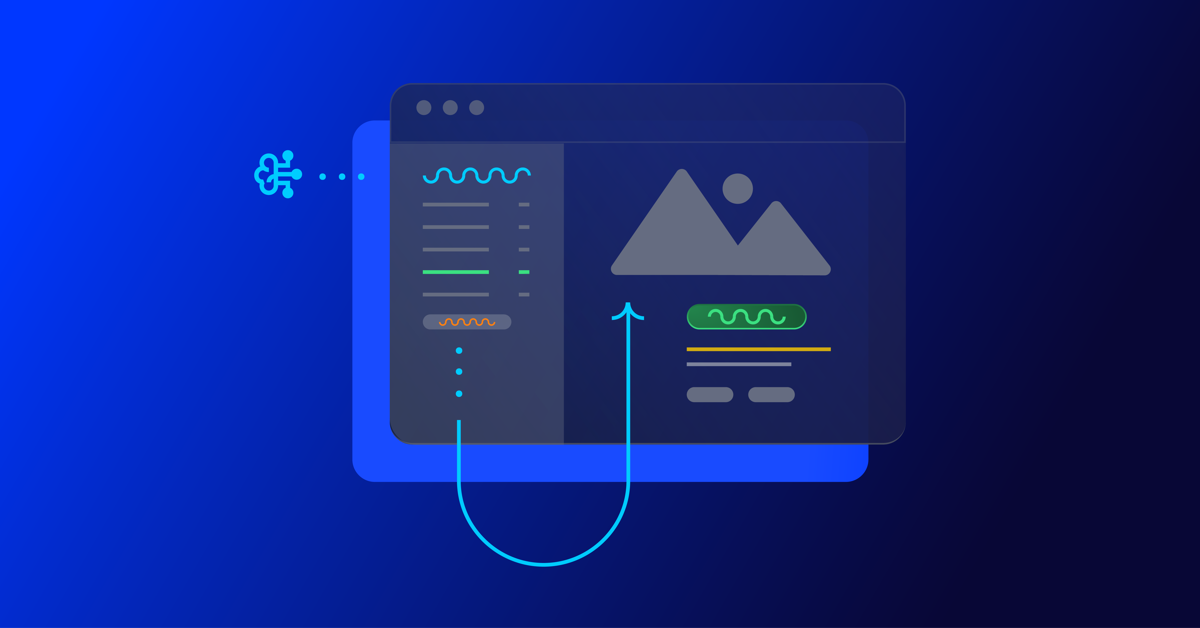
Before diving in to all things editorial guidelines, a quick introduction. I head up the content team here at Optimizely. I’m responsible for developing our content strategy and ensuring this aligns to our key business goals.
Here I’ll take you through the process we used to create new editorial guidelines; things that worked well and tackle some of the challenges that come with any good multi – stakeholder project, share some examples and leave you with a template you can use to set your own content standards.
What are editorial guidelines?
Editorial guidelines are a set of standards for any/all content contributors, etc. etc. This most often includes guidance on brand, tone of voice, grammar and style, your core content principles and the types of content you want to produce.
Editorial guidelines are a core component of any good content strategy and can help marketers achieve the following in their content creation process:
- Consistency: All content produced, regardless of who is creating it, maintains a consistent tone of voice and style, helping strengthen brand image and making it easier for your audience to recognize your company’s content
- Quality Control: Serves as a ‘North Star’ for content quality, drawing a line in the sand to communicate the standard of content we want to produce
- Boosts SEO efforts: Ensures content creation aligns with SEO efforts, improving company visibility and increasing traffic
- Efficiency: With clear guidelines in place, content creators – external and internal – can work more efficiently as they have a clear understanding of what is expected of them
Examples of editorial guidelines
There are some great examples of editorial guidelines out there to help you get started.
Here are a few I used:
1. Editorial Values and Standards, the BBC
Ah, the Beeb. This really helped me channel my inner journalist and learn from the folks that built the foundation for free quality journalism.
How to create editorial guidelines, Pepperland Marketing
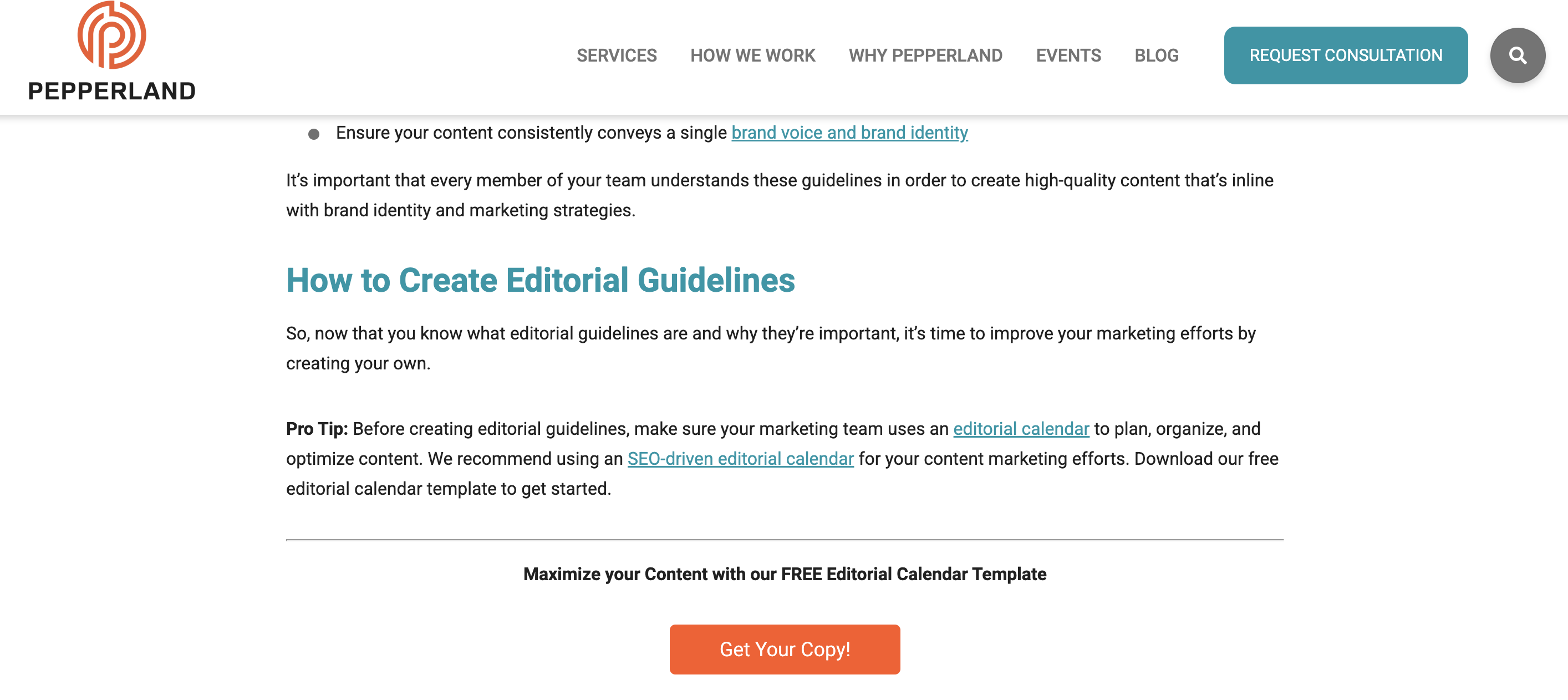
After taking a more big picture view I recognized needed more focused guidance on the step by step of creating editorial guidelines.
I really liked the content the good folks at Pepperland Marketing have created, including a free template – thanks guys! – and in part what inspired me to create our own free template as a way of sharing learnings and helping others quickstart the process of creating their own guidelines.
3. Writing guidelines for the role of AI in your newsroom?… Nieman Lab
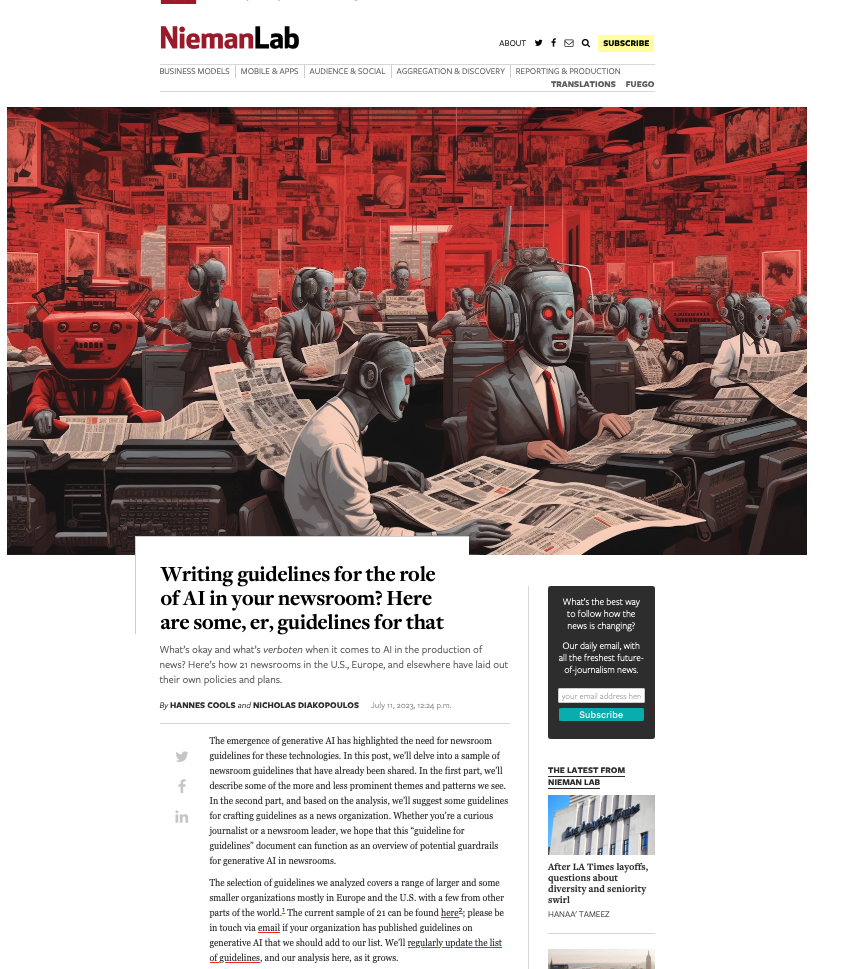
As well as provide guidance on content quality and the content creation process, I wanted to tackle the thorny topic of AI in our editorial guidelines. Specifically, to give content creators a steer on ‘fair’ use of AI when creating content, to ensure creators get to benefit from the amazing power of these tools, but also that content is not created 100% by AI and help them understand why we feel that contravenes our core content principles of content quality.
So, to learn more I devoured this fascinating article, sourcing guidance from major media outlets around the world. I know things change very quickly when it comes to AI, but I highly encourage reading this and taking inspiration from how these media outlets are tackling this topic.
Learn more: The Marketer’s Guide to AI-generated content
Why did we decide to create editorial guidelines?
1. Aligning content creators to a clear vision and process
Optimizely as a business has undergone a huge transformation over the last 3 years, going through rapid acquisition and all the joys and frustrations that can bring. As a content team, we quickly recognized the need to create a set of clear and engaging guidelines that helps content creators understand how and where they can contribute, and gave a clear process to follow when submitting a content idea for consideration.
2. Reinvigorated approach to brand and content
As a brand Optimizely is also going through a brand evolution – moving from a more formal, considered tone of voice to one that’s much more approachable, down to earth and not afraid to use humor, different in content and execution.
See, our latest CMS campaign creative:
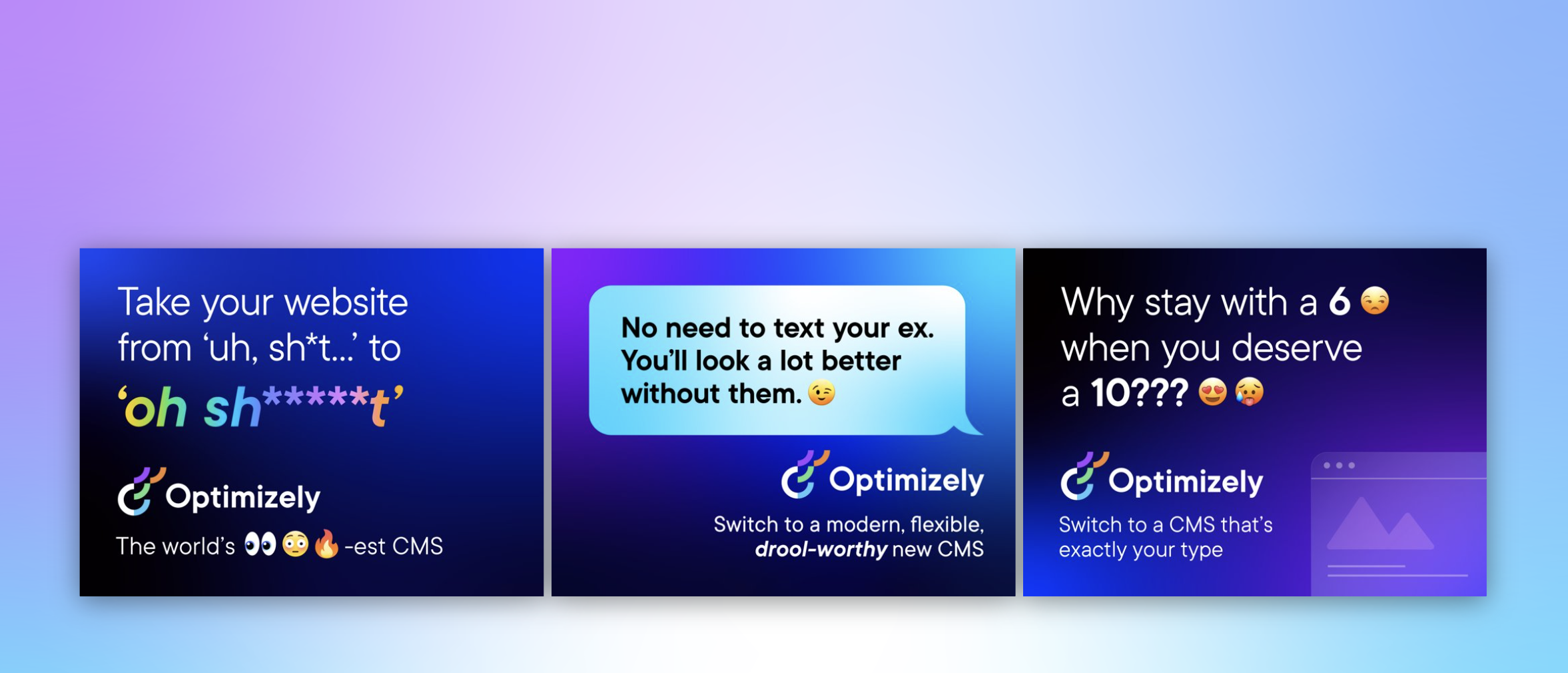
It’s pretty out there in terms of creative and messaging. It’s an ad campaign that’s designed to capture attention yes, but also – to demonstrate our abilities as a marketing team to create this type of campaign that is normally reserved for other more quote unquote creative industries.
We wanted to give guidance to fellow content creators outside the team on how they can also create content that embraces this evolved tone of voice, while at the same time ensuring content adheres to our brand guidelines.
3. Streamline content creation process
Like many global enterprises we have many different content creators, working across different time zones and locations. Documenting a set of guidelines and making them easily available helps content creators quickly understand our content goals, the types of content we want to create and why. It would free up content team time spent with individual contributors reviewing and editing submissions, and would ensure creation and optimization aligns to broader content & business goals.
It was also clear that we needed to document a process for submitting content ideas, so we made sure to include this in the guidelines themselves to make it easy and accessible for all contributors.
4. 2023 retrospective priority
As a content team we regularly review our content strategy and processes to ensure we’re operating as efficiently as possible.
In our last retrospective. I asked my team ‘what was the one thing I could do as a manager to help them be more impactful in their role?’
Editorial guidelines was the number 1 item on their list.
So off we went…
What we did
- Defined a discrete scope of work for the first version of the editorial guidelines, focusing on the Blog and Resources section of the website. This is where the content team spends most of its time and so has most involvement in the content creation process. Also where the most challenging bottlenecks have been in the past
- Research. Reviewed what was out there, got my hands on a few free templates and assembled a framework to create a first version for inputs and feedback
- Asked content community – I put a few questions out to my network on LinkedIn on the topic of content guidelines and content strategy, seeking to get input and guidance from smart marketers.

- Invited feedback: Over the course of a few weekswe invited collaborators to comment in a shared doc as a way of taking iterative feedback, getting ideas for the next scope of work, and also – bringing people on the journey of creating the guidelines. Look at all those reviewers! Doing this within our Content Marketing Platform (CMP) ensured that all that feedback was captured in one place, and that we could manage the process clearly, step by step:
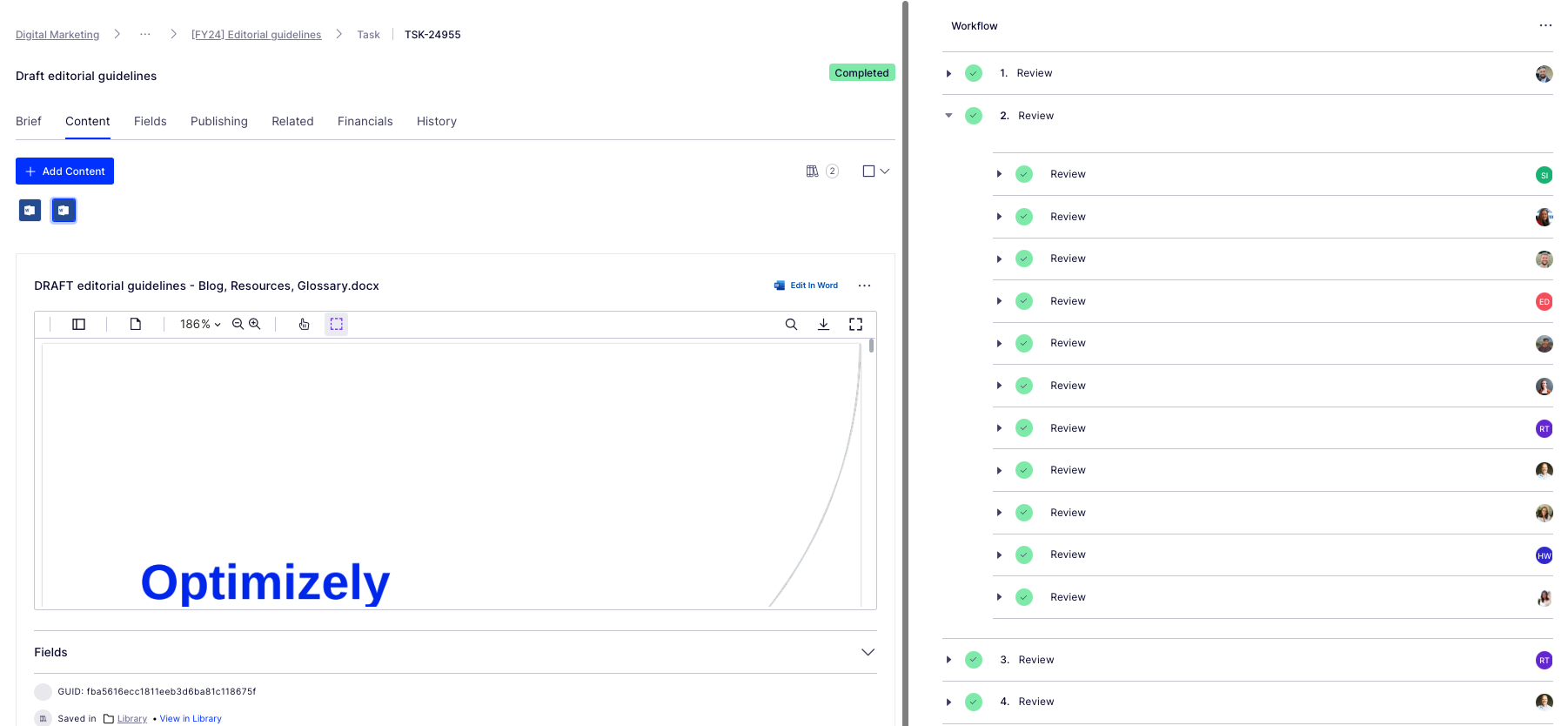
Look at all those collaborators! Thanks guys! And all of those beautiful ticks, so satisfying. So glad I could crop out the total outstanding tasks for this screen grab too (Source – Optimizely CMP)
- Updated content workflow: Now we have clear, documented guidance in place, we’ve included this as a step – the first step – in the workflow used for blog post creation:
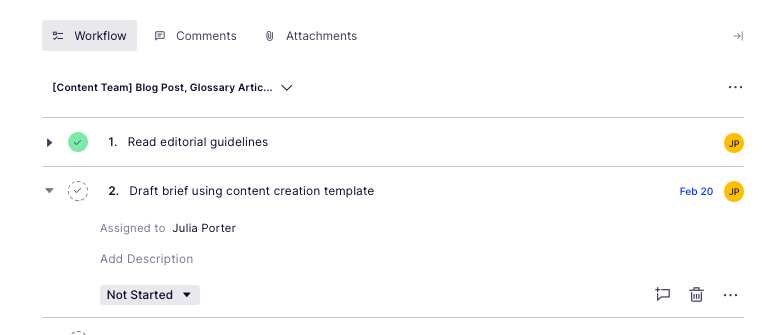
Source: Optimizely CMP
Results
It’s early days but we’re already seeing more engagement with the content creation process, especially amongst the teams involved in building the guidelines (which was part of the rationale in the first place :))

Source: My Teams chat
It’s inspired teams to think differently about the types of content we want to produce going forwards – for the blog and beyond.
I’d also say it’s boosted team morale and collaboration, helping different teams work together on shared goals to produce better quality work.
What’s next?
We’re busy planning wider communication of the editorial guidelines beyond marketing. We’ve kept the original draft and regularly share this with existing and potential collaborators for ongoing commentary, ideas and feedback.
Creating guidelines has also sparked discussion about the types of briefs and templates we want and need to create in CMP to support creating different assets. Finding the right balance between creative approach and using templates to scale content production is key.
We’ll review these guidelines on a quarterly basis and evolve as needed, adding new formats and channels as we go.
Key takeaways
- Editorial guidelines are a useful way to guide content creators as part of your overall content strategy
- Taking the time to do research upfront can help accelerate seemingly complex projects. Don’t be afraid to ask your community for inputs and advice as you create
- Keep the scope small at first rather than trying to align everything all at once. Test and learn as you go
- Work with stakeholders to build guidelines from the ground up to ensure you create a framework that is useful, relevant and used
And lastly, here’s that free template we created to help you build or evolve your own editorial guidelines!
MARKETING
Effective Communication in Business as a Crisis Management Strategy

Everyday business life is full of challenges. These include data breaches, product recalls, market downturns and public relations conflicts that can erupt at any moment. Such situations pose a significant threat to a company’s financial health, brand image, or even its further existence. However, only 49% of businesses in the US have a crisis communications plan. It is a big mistake, as such a strategy can build trust, minimize damage, and even strengthen the company after it survives the crisis. Let’s discover how communication can transform your crisis and weather the chaos.
The ruining impact of the crisis on business
A crisis can ruin a company. Naturally, it brings losses. But the actual consequences are far worse than lost profits. It is about people behind the business – they feel the weight of uncertainty and fear. Employees start worrying about their jobs, customers might lose faith in the brand they once trusted, and investors could start looking elsewhere. It can affect the brand image and everything you build from the branding, business logo, social media can be ruined. Even after the crisis recovery, the company’s reputation can suffer, and costly efforts might be needed to rebuild trust and regain momentum. So, any sign of a coming crisis should be immediately addressed. Communication is one of the crisis management strategies that can exacerbate the situation.
The power of effective communication
Even a short-term crisis may have irreversible consequences – a damaged reputation, high employee turnover, and loss of investors. Communication becomes a tool that can efficiently navigate many crisis-caused challenges:
- Improved trust. Crisis is a synonym for uncertainty. Leaders may communicate trust within the company when the situation gets out of control. Employees feel valued when they get clear responses. The same applies to the customers – they also appreciate transparency and are more likely to continue cooperation when they understand what’s happening. In these times, documenting these moments through event photographers can visually reinforce the company’s messages and enhance trust by showing real, transparent actions.
- Reputation protection. Crises immediately spiral into gossip and PR nightmares. However, effective communication allows you to proactively address concerns and disseminate true information through the right channels. It minimizes speculation and negative media coverage.
- Saved business relationships. A crisis can cause unbelievable damage to relationships with employees, customers, and investors. Transparent communication shows the company’s efforts to find solutions and keeps stakeholders informed and engaged, preventing misunderstandings and painful outcomes.
- Faster recovery. With the help of communication, the company is more likely to receive support and cooperation. This collaborative approach allows you to focus on solutions and resume normal operations as quickly as possible.
It is impossible to predict when a crisis will come. So, a crisis management strategy mitigates potential problems long before they arise.
Tips on crafting an effective crisis communication plan.
To effectively deal with unforeseen critical situations in business, you must have a clear-cut communication action plan. This involves things like messages, FAQs, media posts, and awareness of everyone in the company. This approach saves precious time when the crisis actually hits. It allows you to focus on solving the problem instead of intensifying uncertainty and panic. Here is a step-by-step guide.
Identify your crisis scenarios.
Being caught off guard is the worst thing. So, do not let it happen. Conduct a risk assessment to pinpoint potential crises specific to your business niche. Consider both internal and external factors that could disrupt normal operations or damage the online reputation of your company. Study industry-specific issues, past incidents, and current trends. How will you communicate in each situation? Knowing your risks helps you prepare targeted communication strategies in advance. Of course, it is impossible to create a perfectly polished strategy, but at least you will build a strong foundation for it.
Form a crisis response team.
The next step is assembling a core team. It will manage communication during a crisis and should include top executives like the CEO, CFO, and CMO, and representatives from key departments like public relations and marketing. Select a confident spokesperson who will be the face of your company during the crisis. Define roles and responsibilities for each team member and establish communication channels they will work with, such as email, telephone, and live chat. Remember, everyone in your crisis response team must be media-savvy and know how to deliver difficult messages to the stakeholders.
Prepare communication templates.
When a crisis hits, things happen fast. That means communication needs to be quick, too. That’s why it is wise to have ready-to-go messages prepared for different types of crises your company may face. These messages can be adjusted to a particular situation when needed and shared on the company’s social media, website, and other platforms right away. These templates should include frequently asked questions and outline the company’s general responses. Make sure to approve these messages with your legal team for accuracy and compliance.
Establish communication protocols.
A crisis is always chaotic, so clear communication protocols are a must-have. Define trigger points – specific events that would launch the crisis communication plan. Establish a clear hierarchy for messages to avoid conflicting information. Determine the most suitable forms and channels, like press releases or social media, to reach different audiences. Here is an example of how you can structure a communication protocol:
- Immediate alert. A company crisis response team is notified about a problem.
- Internal briefing. The crisis team discusses the situation and decides on the next steps.
- External communication. A spokesperson reaches the media, customers, and suppliers.
- Social media updates. A trained social media team outlines the situation to the company audience and monitors these channels for misinformation or negative comments.
- Stakeholder notification. The crisis team reaches out to customers and partners to inform them of the incident and its risks. They also provide details on the company’s response efforts and measures.
- Ongoing updates. Regular updates guarantee transparency and trust and let stakeholders see the crisis development and its recovery.
Practice and improve.
Do not wait for the real crisis to test your plan. Conduct regular crisis communication drills to allow your team to use theoretical protocols in practice. Simulate different crisis scenarios and see how your people respond to these. It will immediately demonstrate the strong and weak points of your strategy. Remember, your crisis communication plan is not a static document. New technologies and evolving media platforms necessitate regular adjustments. So, you must continuously review and update it to reflect changes in your business and industry.
Wrapping up
The ability to handle communication well during tough times gives companies a chance to really connect with the people who matter most—stakeholders. And that connection is a foundation for long-term success. Trust is key, and it grows when companies speak honestly, openly, and clearly. When customers and investors trust the company, they are more likely to stay with it and even support it. So, when a crisis hits, smart communication not only helps overcome it but also allows you to do it with minimal losses to your reputation and profits.
MARKETING
Should Your Brand Shout Its AI and Marketing Plan to the World?

To use AI or not to use AI, that is the question.
Let’s hope things work out better for you than they did for Shakespeare’s mad Danish prince with daddy issues.
But let’s add a twist to that existential question.
CMI’s chief strategy officer, Robert Rose, shares what marketers should really contemplate. Watch the video or read on to discover what he says:
Should you not use AI and be proud of not using it? Dove Beauty did that last week.
Should you use it but keep it a secret? Sports Illustrated did that last year.
Should you use AI and be vocal about using it? Agency giant Brandtech Group picked up the all-in vibe.
Should you not use it but tell everybody you are? The new term “AI washing” is hitting everywhere.
What’s the best option? Let’s explore.
Dove tells all it won’t use AI
Last week, Dove, the beauty brand celebrating 20 years of its Campaign for Real Beauty, pledged it would NEVER use AI in visual communication to portray real people.
In the announcement, they said they will create “Real Beauty Prompt Guidelines” that people can use to create images representing all types of physical beauty through popular generative AI programs. The prompt they picked for the launch video? “The most beautiful woman in the world, according to Dove.”
I applaud them for the powerful ad. But I’m perplexed by Dove issuing a statement saying it won’t use AI for images of real beauty and then sharing a branded prompt for doing exactly that. Isn’t it like me saying, “Don’t think of a parrot eating pizza. Don’t think about a parrot eating pizza,” and you can’t help but think about a parrot eating pizza right now?
Brandtech Group says it’s all in on AI
Now, Brandtech Group, a conglomerate ad agency, is going the other way. It’s going all-in on AI and telling everybody.
This week, Ad Age featured a press release — oops, I mean an article (subscription required) — with the details of how Brandtech is leaning into the takeaway from OpenAI’s Sam Altman, who says 95% of marketing work today can be done by AI.
A Brandtech representative talked about how they pitch big brands with two people instead of 20. They boast about how proud they are that its lean 7,000 staffers compete with 100,000-person teams. (To be clear, showing up to a pitch with 20 people has never been a good thing, but I digress.)
OK, that’s a differentiated approach. They’re all in. Ad Age certainly seemed to like it enough to promote it. Oops, I mean report about it.
False claims of using AI and not using AI
Offshoots of the all-in and never-will approaches also exist.
The term “AI washing” is de rigueur to describe companies claiming to use AI for something that really isn’t AI. The US Securities and Exchange Commission just fined two companies for using misleading statements about their use of AI in their business model. I know one startup technology organization faced so much pressure from their board and investors to “do something with AI” that they put a simple chatbot on their website — a glorified search engine — while they figured out what they wanted to do.
Lastly and perhaps most interestingly, companies have and will use AI for much of what they create but remain quiet about it or desire to keep it a secret. A recent notable example is the deepfake ad of a woman in a car professing the need for people to use a particular body wipe to get rid of body odor. It was purported to be real, but sharp-eyed viewers suspected the fake and called out the company, which then admitted it. Or was that the brand’s intent all along — the AI-use outrage would bring more attention?
This is an AI generated influencer video.
Looks 100% real. Even the interior car detailing.
UGC content for your brand is about to get really cheap. ☠️ pic.twitter.com/2m10RqoOW3
— Jon Elder | Amazon Growth | Private Label (@BlackLabelAdvsr) March 26, 2024
To yell or not to yell about your brand’s AI decision
Should a brand yell from a mountaintop that they use AI to differentiate themselves a la Brandtech? Or should a brand yell they’re never going to use AI to differentiate themselves a la Dove? Or should a brand use it and not yell anything? (I think it’s clear that a brand should not use AI and lie and say it is. That’s the worst of all choices.)
I lean far into not-yelling-from-mountaintop camp.
When I see a CEO proudly exclaim that they laid off 90% of their support workforce because of AI, I’m not surprised a little later when the value of their service is reduced, and the business is failing.
I’m not surprised when I hear “AI made us do it” to rationalize the latest big tech company latest rounds of layoffs. Or when a big consulting firm announces it’s going all-in on using AI to replace its creative and strategic resources.
I see all those things as desperate attempts for short-term attention or a distraction from the real challenge. They may get responses like, “Of course, you had to lay all those people off; AI is so disruptive,” or “Amazing. You’re so out in front of the rest of the pack by leveraging AI to create efficiency, let me cover your story.” Perhaps they get this response, “Your company deserves a bump in stock price because you’re already using this fancy new technology.”
But what happens if the AI doesn’t deliver as promoted? What happens the next time you need to lay off people? What happens the next time you need to prove your technologically forward-leaning?
Yelling out that you’re all in on a disruptive innovation, especially one the public doesn’t yet trust a lot is (at best) a business sugar high. That short-term burst of attention may or may not foul your long-term brand value.
Interestingly, the same scenarios can manifest when your brand proclaims loudly it is all out of AI, as Dove did. The sugar high may not last and now Dove has itself into a messaging box. One slip could cause distrust among its customers. And what if AI gets good at demonstrating diversity in beauty?
I tried Dove’s instructions and prompted ChatGPT for a picture of “the most beautiful woman in the world according to the Dove Real Beauty ad.”
It gave me this. Then this. And this. And finally, this.
She’s absolutely beautiful, but she doesn’t capture the many facets of diversity Dove has demonstrated in its Real Beauty campaigns. To be clear, Dove doesn’t have any control over generating the image. Maybe the prompt worked well for Dove, but it didn’t for me. Neither Dove nor you can know how the AI tool will behave.
To use AI or not to use AI?
When brands grab a microphone to answer that question, they work from an existential fear about the disruption’s meaning. They do not exhibit the confidence in their actions to deal with it.
Let’s return to Hamlet’s soliloquy:
Thus conscience doth make cowards of us all;
And thus the native hue of resolution
Is sicklied o’er with the pale cast of thought,
And enterprises of great pith and moment
With this regard their currents turn awry
And lose the name of action.
In other words, Hamlet says everybody is afraid to take real action because they fear the unknown outcome. You could act to mitigate or solve some challenges, but you don’t because you don’t trust yourself.
If I’m a brand marketer for any business (and I am), I’m going to take action on AI for my business. But until I see how I’m going to generate value with AI, I’m going to be circumspect about yelling or proselytizing how my business’ future is better.
HANDPICKED RELATED CONTENT:
Cover image by Joseph Kalinowski/Content Marketing Institute
-

 PPC7 days ago
PPC7 days ago19 Best SEO Tools in 2024 (For Every Use Case)
-
SEARCHENGINES6 days ago
Daily Search Forum Recap: April 19, 2024
-

 WORDPRESS7 days ago
WORDPRESS7 days agoHow to Make $5000 of Passive Income Every Month in WordPress
-

 MARKETING6 days ago
MARKETING6 days agoBattling for Attention in the 2024 Election Year Media Frenzy
-

 WORDPRESS5 days ago
WORDPRESS5 days ago13 Best HubSpot Alternatives for 2024 (Free + Paid)
-

 SEO7 days ago
SEO7 days ago25 WordPress Alternatives Best For SEO
-

 WORDPRESS6 days ago
WORDPRESS6 days ago7 Best WooCommerce Points and Rewards Plugins (Free & Paid)
-

 MARKETING7 days ago
MARKETING7 days agoTinuiti Marketing Analytics Recognized by Forrester





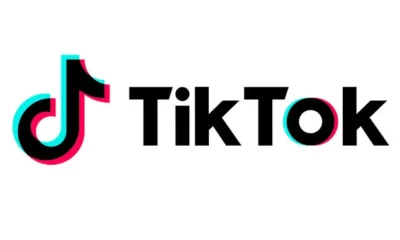











You must be logged in to post a comment Login